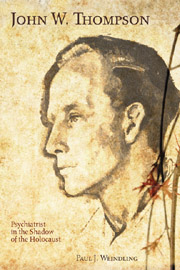Book contents
- Frontmatter
- Contents
- List of Illustrations
- Acknowledgments
- List of Abbreviations
- Part One Into the Dark
- 1 “Ecce Homo”
- 2 Mexican Childhood
- 3 Palo Alto Schooling, Stanford Student
- 4 Transatlantic Physiologist
- 5 Edinburgh Physician
- 6 Excitable Harvard
- 7 High Altitude and Rapid Descent
- 8 Auden, Anxiety, and the German Mind
- Part Two Redemption
- Part Three Aftermath
- Appendix John Thompson's Writings
- Notes
- Sources
- Index
5 - Edinburgh Physician
from Part One - Into the Dark
Published online by Cambridge University Press: 12 September 2012
- Frontmatter
- Contents
- List of Illustrations
- Acknowledgments
- List of Abbreviations
- Part One Into the Dark
- 1 “Ecce Homo”
- 2 Mexican Childhood
- 3 Palo Alto Schooling, Stanford Student
- 4 Transatlantic Physiologist
- 5 Edinburgh Physician
- 6 Excitable Harvard
- 7 High Altitude and Rapid Descent
- 8 Auden, Anxiety, and the German Mind
- Part Two Redemption
- Part Three Aftermath
- Appendix John Thompson's Writings
- Notes
- Sources
- Index
Summary
Edinburgh Return
When Thompson returned to Edinburgh as a demonstrator in physiology in 1933, he took a circuitous route. He thought of becoming a demonstrator in neurology in Paris and studying for a doctorat ès science. He worked in the laboratories of the pathological anatomist Ludwig Aschoff in Freiburg and the preeminent neurophysiologist Santiago Ramón y Cajal in Madrid. Visiting Berlin, he took an interest in psychoanalysis.
Finally resuming his studies, Thompson became immersed in demanding clinical training. He clerked and examined patients in Ward 19 (the students' ward) of the Royal Infirmary. He worked on the wards for over twenty-seven months. The hours were long and tiring. He learned to communicate with patients as people. Assisting with birth, death, sickness, and recovery made life worth living. His experience bore out the medical humanist Sir William Osler's view of the hospital as a college—a place where learning and healing went hand in hand.
Thompson studied mental diseases with David Kennedy Henderson, tuberculosis under Sir Robert Philip (pioneer of the first TB dispensary) in 1935, and assisted with twelve births at the Rotunda in Dublin—a renowned maternity hospital. He thought of becoming a neurosurgeon (his examination marks in surgery were high), having been supervised and examined by Sir David Wilkie, who approached surgery on a scientific basis. Thompson concluded, “My education was obtained entirely in Edinburgh.”
- Type
- Chapter
- Information
- John W. ThompsonPsychiatrist in the Shadow of the Holocaust, pp. 30 - 42Publisher: Boydell & BrewerPrint publication year: 2010



